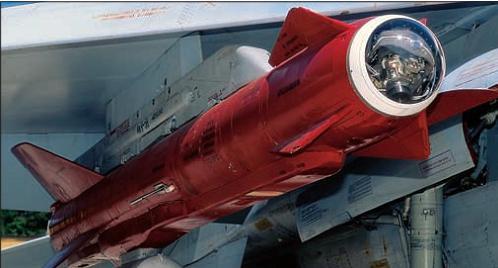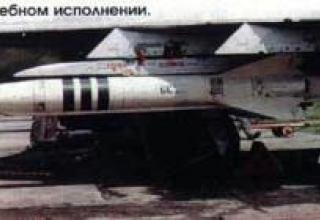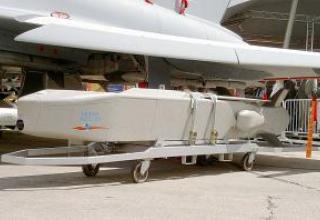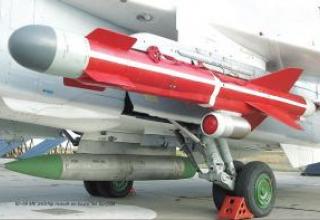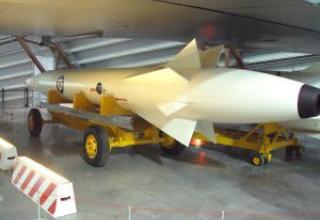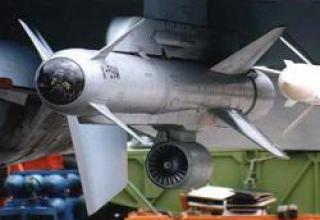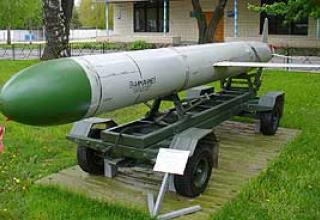The X-59 medium-range tactical missile is designed to engage small ground targets, the coordinates of which are determined before the launch of the missile.
It was developed by the Rainbow Design Bureau and manufactured at the Smolensk Aviation Plant. X-59 was a development of X-29T missile, which has established itself as a high-precision weapon, using a number of successful schematic solutions X-58. However, the original intention to create a "television version" of Kh-58 had to be rejected: the high-speed profile of the flight of X-58 did not provide on the flight to the target the required time for search, recognition and "binding" to the target of the television CNS.
Since 1982, the X-59 missile had been tested on the Su-17M4 fighter-bomber. The tests yielded excellent results: the missiles repeatedly hit a target within a radius of 1-1.5 m from the "cross". By 1984, the tests were completed with a positive conclusion and the X-59 was recommended for equipping the fighter-bombers in service, but eventually abandoned in favour of introducing missiles on the Su-24M front bombers, where the navigator acted as the guidance operator. The decision was motivated not so much by ergonomic considerations as by the rapid shutdown of the Su-17M4. As a result, the Su-24M became the only aircraft of the Soviet and Russian Air Forces to be armed with the X-59.
Its designers were awarded the USSR State Prize in 1984 for the development of the "high-precision X-59 aircraft complex".
X-59 missile was first demonstrated at the Air Show in Dubai in 1991.
In the west, X-59 was designated AS-13 "Kingbolt".
Later, on the basis of this missile were created modified versions of the X-59M family of missiles with extended range and a new engine.
Composition:
Two-stage rocket X-59 is made according to the aerodynamic scheme "tailless" with an X-shaped wing and destabilizer of variable geometry (during transportation, folded) (see projections).
The missile is equipped with two RDTTs: a launch in the drop-off block and a two-nozzle march (the return to the side nozzles was caused by occupation of the tail part by the antenna block). After completing the work, the starting engine is fired off with the help of pyrotractors. The marching engine has a small specific impulse and provides a flight speed of about 285 m/s on the trajectory. BC is a high-explosive high-explosive missile weighing 148 kg, which is used to hit sturdy small targets.
The missile is controlled by electromechanical steering drives powered by the onboard battery and converter. For low-altitude flight, the equipment includes a radio altimeter. The main structural materials are light alloys and high-strength stainless steel VNS-2 in the fuselage units, the wing is welded from light alloy AMG-6 with spars from ON-3. To ensure the thermal insulation of the cargo compartment and hardware compartments X-59 from the inside are glued with a layer of synthetic material, and gargots with fittings and power supply wiring to increase rigidity is filled with foam plastic, along with the installed in it harnesses and connectors.
In order to improve reliability, survivability and operating conditions, the missile is arranged in compartments. Each compartment contains the systems most functionally connected to each other.
This arrangement allows:
- apply a controlled directional antenna of the required diameter at the minimum fuselage middles of the missile,
- to replace combat units without undoing the waveguide path,
- to make optimum use of the cooling air coming from the carrier plane,
- provide easy access to the electrical components during operation .
To protect the optical fairing of the TV-Command Guidance equipment from mechanical damage and aerodynamic heating in the course of a joint flight, the missile has a protective cone, which with the system of its reset and destabilizer deployment is placed in front of the video fairing.
There are two ways to point the X-59 missile - autonomous and autonomous navigating.
During autonomous pointing before launch, the target coordinates are recorded in the memory of the onboard missile control system. Connection of a two-way line of television and radio command communication occurs after the launch of the rocket engine that opens the antenna of the rocket. After that, the image of space on the flight course is broadcast on board. The rocket goes to the target area, taking into account the terrain (from 15 to 1000 m), performs the flight (with the help of autopilot SNAU-59) until the target is detected on the screen of the video command device (VCU) in the cockpit of the navigator. Having identified the target, the navigator on the screen of the VCU puts a moving crosshairs on the target and presses the button binding automatic tracking system "Tube". After that the missile is guided to the target by itself.
Autonomous navigational guidance is carried out in the presence of specific ground long landmarks on the flight path of the missile or in the presence of guidelines for correction in the target area. In this method, the missile is guided throughout the flight from the moment of separation from the carrier both by autopilot commands and by manual control from the handle of the crosshair mechanism (MUL) at the navigator. Circuit deviation of X-59 with this method of guidance is only 2 - 3 meters, but the missile can be used only in clear weather with good visibility of the target and the presence of visible landmarks that provide guidance. In the system tests, the best results were achieved by guidance using contrasting linear markers of a river, highway or railroad type that led to the target, otherwise the task was problematic.
For the X-59 missile on the carrier aircraft it is necessary to have a special hanging container, type APK-8. Hardware hanging container, equipped with antenna blocks of the front and rear hemisphere, provides the process of guidance and after turning the carrier on the reverse course, allowing the aircraft to withdraw from the attack after launch, not entering the anti-aircraft gun, and real-time radio command correction allowed you to confidently hit even low-contrast objects, "unsuitable" for conventional TGSN, to which those could not make a binding. The use of an overhead container makes it possible to use X-59 missile from various carriers, including foreign ones.
The advantages of the Tekon-1 telescopic guidance system (developed by MNIITI) are:
- the possibility of "remote" search and detection of the target by means of a television head at a considerable distance from the carrier (previously the process was carried out when the missiles were mounted on a suspension and was limited to a small distance from the target if possible to visually detect it);
- significantly increased accuracy of hitting - guidance by the pilot is possible practically before the target is hit;
- full control of the missile, including when the aircraft departs from the target.
For suspension and start-up of X-59 is a unified aviation catapult device AKU-58-1.
A thermal container is used for transportation and storage of the rocket.
Characteristics:
| Range of fire, km | 40 |
| Shooting accuracy (CWO), m | 2-3 |
| Flight Speed, m/s | 285 |
| The length of the rocket, mm | 5368 - 5370 |
| Maximum rocket body diameter, mm | 380 |
| Wingspan, mm | 1260 (1170) |
| Start weight , kg | 760-790 |
| Aviation launcher AKU-58 | |
| Number of rockets per PU | 1 |
| Developer | Vimpel ICB |
| Weight of empty PU, kg | 185 |
| Length PU, mm | 3810 |
| PU width, mm | 130 |
| Height PU, mm | 220 |
Testing:
The first flight of the prototype carrier aircraft Tu-95M-55 (BM-021) took place on July 31, 1978. A total of 107 flights and launches of ten X-55s were made on this machine by the beginning of 1982. The plane was lost in the crash January 28, 1982 on takeoff from Zhukovsky because of pilot error.
The tests of the X-55 were very intensive, which was facilitated by a thorough pre-testing of the control system on the model stands of NIIAS. During the first stage of the tests 12 launches were conducted, only one of which failed due to the power system generator failure. In addition to the missile itself, the weapon control system was brought to the surface of the launch vehicle, which was used to launch the mission and exhibit the missile's gyroinertial platforms.
The first launch of the serial X-55 was made February 23, 1981. September 3, 1981 the first set-off launch was made with the first production car Tu-95MS. Tests of the complex were conducted on the route measuring complex of the 929th LIC. Test launches of X-55 were carried out virtually the entire range of flight modes of the carrier from altitudes of 200m to 10km. The engine was launched reliably, the speed on the route, adjustable depending on weight loss during fuel production, was maintained in the range of 720-830 km/h. With a given value of CVO not more than 100m in a number of starts a deviation of only 20-30m was achieved.
The first to master the new complex started in Semipalatinsk 1223rd TBAP, which on December 17, 1982. arrived two new Tu-95MS. Since 1984, retraining on the Tu-95MS began adjacent 1226th TBAP of the same Semipalatinsk 79th TBAD. At the same time there was equipping of Tu-95MS regiments YES in the European part of the USSR - 1006 TBAP in Uzin near Kiev and 182nd TBAP in Mozdok, which was part of the 106th TBAD. In the division were concentrated more advanced Tu-95MS-16. The first Tu-160 arrived in April 1987 in the 184th TBAP, which was located in Priluki in Ukraine. Three months later, August 1, 1987 the crew of regiment commander V.Grebennikov first performed the launch of X-55.
After the collapse of the USSR, most of the X-55 missiles and their carrier aircraft remained outside Russia, in particular, in Kazakhstan and Ukraine, where there were, respectively, 40 Tu-95MS in Semipalatinsk, 25 in Uzin and 21 Tu-160 in Priluki. Together with the aircraft in the Ukrainian bases remained 1068 missiles X-55. With Kazakhstan, we managed to agree quickly enough, exchanging heavy bombers for proposed Russian fighters and attack aircraft. By February 19, 1994 all TU-95MS were ferried to the Far Eastern airfields, where they were equipped with the 182nd and 79th TBAP. The negotiations with Ukraine lasted a long time. Eventually, three TU-95MS and eight TU-160, which flew to Engels in February 2000, were transferred by the Ukrainian side on account of debts for gas. At the end of 1999, 575 air-based cruise missiles X-55 and X-55SM were also delivered from Ukraine to Russia.
In the Russian Air Force, all the forces of the YES were combined into the 37th Air Force. In its composition by July 2001, there were 63 Tu-95MS aircraft with 504 missiles Kh-55, as well as 15 Tu-160. The first practical launch of X-55SM from the Tu-160 was made by the crew of Colonel A. Zhikharev October 22, 1992. In June 1994, four Tu-95MS and Tu-160 took part in the exercises of the Russian Strategic Nuclear Forces, having worked out tactical launches over the North Sea and then executed the actual firing of X-55SM at the range. In September 1998, a group of four Tu-95MS 184th TBAP were made launches of X-55 in the area of the Northern Fleet training ground Chizha, where the missiles were 1500 km to the target.
During the exercise "West 99" in June 1999, a pair of Tu-95MS from Engels performed a 15-hour flight, reaching Iceland, and on the way back made a launch of X-55 on a training target in the Caspian Sea. In October 2002, the crew of the Tu-160 Colonel Yu Deineko in a night flight passed the route over the circumpolar areas, performing a practical launch of X-55SM. May 14, 2003 the four Tu-95MS and six Tu-160 participated in exercises covering the Persian Gulf and the Indian Ocean. Launches of the X-55 from the Tu-95MS were held during the strategic command training of land, sea and air SNF in February 2004.
Sources:
- А.В.Карпенко, С.М. Ганин "Отечественные авиационные тактические ракеты", "Бастион" N1, 2000г.
- В.Марковский, К.Перов "Советские авиационные ракеты "воздух-земля", М., Экспринт, 2005г.

